|
|
|
Sort Order |
|
|
|
Items / Page
|
|
|
|
|
|
|
| Srl | Item |
| 1 |
ID:
190181
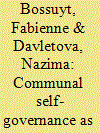

|
|
|
|
|
| Summary/Abstract |
In the European Union’s (EU) new Strategy for Central Asia, which was launched in May 2019, boosting the resilience of Central Asian societies is singled out as a key priority. Drawing on post-development thinking, this article argues that if the EU is serious about promoting resilience to empower ‘the local’ and contribute towards a truly sustainable future for the societies of Central Asian countries, then the EU will need to embrace a de-centred, post-neoliberal approach to resilience. This implies that the EU would have to accept ‘the other’ – in this case, the Central Asian societies – for what they are and advocate home-grown self-organization based on a deep understanding of the local meaning of good life and local knowledge about the available resources. Empirical illustrations to substantiate this claim are drawn from a concrete case, namely the mahalla in Uzbekistan.
|
|
|
|
|
|
|
|
|
|
|
|
|
|
|
|
| 2 |
ID:
190177


|
|
|
|
|
| Summary/Abstract |
Since the collapse of the USSR, the European Union (EU) and China have launched a range of leadership initiatives in Central Asia. Focusing on non-traditional security, connectivity and water management cooperation, this paper contributes to the special issue by highlighting the evolution of the EU's goals and practices in Central Asia, contrasting them with China's leadership strategy, and discussing implications for states in the region. The EU and China have diverging approaches to Central Asia due to differences in foreign policy goals and domestic politics. Nevertheless, as of now there seems to be no rivalry between their projects, as neither claims sole leadership nor builds formal institutions with exclusive membership. The presence of two very different leaders is beneficial for Central Asian states as it has allowed them to draw more material resources, generate new ideas, diversify partners and balance external influence.
|
|
|
|
|
|
|
|
|
|
|
|
|
|
|
|
| 3 |
ID:
190180
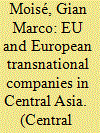

|
|
|
|
|
| Summary/Abstract |
This article argues that in the contentious energy market of Central Asia transnational corporations (TNCs) and local governments are the real forces at play. While the European Union (EU) has repeatedly shown interest in the region, scarce profitability of the economic ventures and lack of control over the actual investors have resulted in a loss of interest. Deconstructing the EU energy security strategy towards Central Asia, this article reflects how TNCs formally based in Europe have used the ‘Shield of Nationality’ as protection from the blows of resource-rich governments, while remaining driven by capital accumulation. A case study of the Italian oil and gas company ENI in Kazakhstan highlights how the mediation of home governments between corporations and local administrations depends on its relationship with the TNC. The article suggests that future research of the energy sector should consider the role of TNCs and their ambiguous relationship with their ‘home countries’.
|
|
|
|
|
|
|
|
|
|
|
|
|
|
|
|
| 4 |
ID:
190173
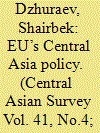

|
|
|
|
|
| Summary/Abstract |
One of the distinguishing characteristics of the European Union’s (EU) policy in Central Asia has been its continuity. Although the EU has recently revised its strategy for the region, Brussels’ priorities saw little change both thematically and in terms of approach. This article argues that two mutually reinforcing factors help explain the continuity of the EU’s Central Asia policy. First, the sui generis nature of the EU means the decision-making system is both complex and decentralized. The multitude of veto actors serves to make the status quo more realistic. Furthermore, the EU leadership is immune from the incentives and pressures of domestic political competition, an essential factor in the foreign policymaking of national leaders. The compounding factor is Central Asia’s peripherality for Brussels. The region is distant geographically and marginal economically. As a result, continuing existing approaches and commitments remains the least costly and most feasible policy option.
|
|
|
|
|
|
|
|
|
|
|
|
|
|
|
|
| 5 |
ID:
190172
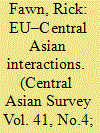

|
|
|
|
|
| Summary/Abstract |
By shifting the study of European Union (EU)–Central Asian relations from its fixed category of black-boxing both the EU and Central Asia, this article advances the case for the approach of examining multi-level and multi-actor interactions that identify the dynamic processes of reciprocal action and meaning-making that characterize the mutual cooperation. It distinguishes perceptions, interests and practices, pointing to the rationales and modes of behaviour of multiple EU and Central Asian actors. The article also advances five reasons why EU studies should take more interest in Central Asia, given that the EU’s larger external relations and security agenda extends to this region. Similarly, it shows that Central Asian studies can benefit from the analysis of the region’s interactions with external actors, including the EU, given that external actors contribute to reshaping national policy agendas and influence everyday life.
|
|
|
|
|
|
|
|
|
|
|
|
|
|
|
|
| 6 |
ID:
190179


|
|
|
|
|
| Summary/Abstract |
In the last decade, a growing body of literature has investigated the promotion of good governance, rule of law, democracy and human rights in Central Asia through funding from the European Union (EU). Most of this research has taken an EU-centric approach and is concerned with the supply side of external democratization. As a result, little is known about how EU projects are implemented on the ground and what EU-funded civil society organizations consider to be their priorities. This article investigates the agency of such organizations in Kyrgyzstan by focusing on their contribution to one particular EU instrument: the Instrument contributing to Stability and Peace (IcSP), and its programme: Strengthening Resilience to Violence and Extremism (STRIVE). The findings offer new insights into the processes of adaptation, reinterpretation and contestation through which EU-funded organizations exercise ownership while engaging in the prevention of violent extremism (PVE).
|
|
|
|
|
|
|
|
|
|
|
|
|
|
|
|
| 7 |
ID:
190176
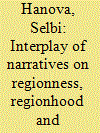

|
|
|
|
|
| Summary/Abstract |
This paper identifies the interplay between narratives on Central Asia as a region. It compares European Union (EU) narratives with those of the five post-Soviet states of Kazakhstan, Kyrgyzstan, Tajikistan, Turkmenistan and Uzbekistan. By doing so, it investigates the manifestations of narratives, stories and narrators who continue to construct and convey certain discourses about the region, comparing EU discourse and that of the local political elites in Central Asia, respectively. By looking at official discourse conveyed by the presidents of the countries and in key foreign policy documents, the interplay of narratives as dialogues between narrators is analysed, thus expanding into ideational analysis, an emerging trend in the literature on post-Soviet Central Asia.
|
|
|
|
|
|
|
|
|
|
|
|
|
|
|
|
| 8 |
ID:
190174
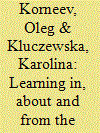

|
|
|
|
|
| Summary/Abstract |
Examining the European Union’s (EU) engagement with Central Asia since the early 1990s, we see an increased commitment to context sensitivity. Arguably, in order to design ‘better’ interventions, the EU needs to know more about this region. This article explores three means of EU learning: in the field – through EU officials’ first-hand experience of working at EU Delegations in Central Asia; about the field – through programmed channels of external expert knowledge, and in particular think tanks; and from the field – during institutionalized consultations with multiple local actors, such as academics, journalists and non-governmental organizations. It is argued that despite this complex learning infrastructure, EU knowledge production on Central Asia has a predominantly performative character. Rather than leading to changes in its relations with Central Asia, new knowledge produced by the EU aims at legitimizing this organization’s pre-existing frameworks of engagement and practices of interactions with the region, and substantiating existing policy priorities.
|
|
|
|
|
|
|
|
|
|
|
|
|
|
|
|
| 9 |
ID:
190175
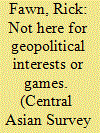

|
|
|
|
|
| Summary/Abstract |
The European Union’s (EU) 2019 New Strategy for Central Asia and joint meetings with Central Asia’s five foreign ministers established standards and expectations for mutual relations. Throughout those initiatives and proclamations, the EU stresses its un-geopolitical essence and behaviour, including the statement that affords the article’s title. The article identifies five issue areas that demonstrate that, despite declarations otherwise, the EU reasons and acts geopolitically in this contested region: (1) the promotion of Central Asian regionalism; (2) the inclusion of Central Asia in formations beneficial to the EU; (3) selectively in economic and functionalist cooperation; (4) democracy, human rights and civil society promotion; and (5) international education cooperation. The EU identifies its comparative advantage through cost–benefit analyses and seeks to enhance its attractiveness by offering its allies to Central Asia, while excluding other, present actors. That the EU is often outmanoeuvred does not diminish this subtle yet discernible geopolitical conduct.
|
|
|
|
|
|
|
|
|
|
|
|
|
|
|
|
| 10 |
ID:
190178


|
|
|
|
|
| Summary/Abstract |
In Central Asia the European Union (EU) positions itself as a benign and gentle actor with no geopolitical intentions. But is this self-prescribed image of a ‘force for good’ shared by Central Asians? To answer this question, the article scrutinizes whether the EU is perceived as posing a threat to or offering an opportunity in Kazakhstan and Kyrgyzstan. Theoretically it is argued that the EU cannot unilaterally claim a certain role in the region; rather, perceptions held by Central Asians partly determine what kind of actor the EU can be and what kind of policies it can successfully implement. The article finds that opportunity/threat perceptions are highly issue specific. Depending on a particular issue area, the EU’s image may change from that of an opportunity to a threat, or vice versa. Yet, the opportunity aspect visibly prevails in both countries, which can be regarded as the EU’s comparative advantage vis-à-vis other actors in the region.
|
|
|
|
|
|
|
|
|
|
|
|
|
|
|
|
|
|
|
|
|